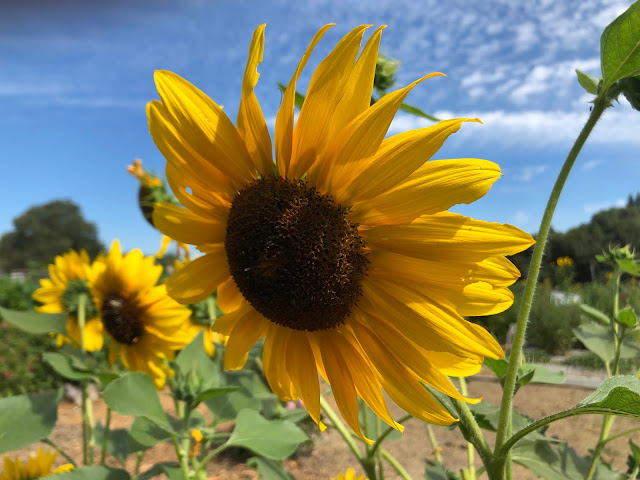
Keep garden hydrated and cool as possible

|
|
At least sunflowers don’t add to the high temperatures — they just add summer cheerfulness. (Photo:
Kathy Morrison) |
How hot can it get? This weekend may show us.
According to the National Weather Service, Sacramento’s high temperatures will flirt with our all-time record of 114 degrees.
Excessive heat warnings are in effect until Monday night. The weather service recommends people and pets stay indoors after 10 a.m.
Unfortunately, your garden can’t come inside or turn on the air conditioning. It’s going to have to wait until the return of the Delta Breeze on Tuesday before it gets some temperature relief.
In the meantime, concentrate on keeping your garden – and yourself – as cool, hydrated and comfortable as possible:
* Keep your vegetable garden watered, mulched and weeded. Water before 8 a.m. to reduce the chance of fungal infection and to conserve moisture.
* Don’t let tomatoes dry out completely. Give tomatoes a deep watering two to three times a week.
* Check soil moisture and irrigate where needed. Container plants may need daily watering.
* Deep water trees and shrubs.
* Pinch back chrysanthemums for bushy plants and more flowers in September.
* Harvest tomatoes, squash, peppers and eggplant. Prompt picking will help keep plants producing.
* Remove spent flowers from roses, daylilies and other shrubs and perennials as they finish flowering.
* Pinch off blooms from basil so the plant will grow more leaves.
* Cut back lavender after flowering to promote a second bloom.
* One good thing about hot days: Most lawns stop growing when temperatures top 95 degrees. Keep mower blades set on high.
Comments
0 comments have been posted.Sacramento Digs Gardening to your inbox.
Sites We Like
Garden Checklist for week of April 21
This week there’s plenty to keep gardeners busy. With no rain in the immediate forecast, remember to irrigate any new transplants.
* Weed, weed, weed! Get them before they flower and go to seed.
* April is the last chance to plant citrus trees such as dwarf orange, lemon and kumquat. These trees also look good in landscaping and provide fresh fruit in winter.
* Smell orange blossoms? Feed citrus trees with a low dose of balanced fertilizer (such as 10-10-10) during bloom to help set fruit. Keep an eye out for ants.
* Apply slow-release fertilizer to the lawn.
* Thoroughly clean debris from the bottom of outdoor ponds or fountains.
* Spring brings a flush of rapid growth, and that means your garden is really hungry. Feed shrubs and trees with a slow-release fertilizer. Or mulch with a 1-inch layer of compost.
* Azaleas and camellias looking a little yellow? If leaves are turning yellow between the veins, give them a boost with chelated iron.
* Trim dead flowers but not leaves from spring-flowering bulbs such as daffodils and tulips. Those leaves gather energy to create next year's flowers. Also, give the bulbs a fertilizer boost after bloom.
* Pinch chrysanthemums back to 12 inches for fall flowers. Cut old stems to the ground.
* Mulch around plants to conserve moisture and control weeds.
* From seed, plant beans, beets, cantaloupes, carrots, corn, cucumbers, melons, radishes and squash.
* Plant onion sets.
* In the flower garden, plant seeds for asters, cosmos, celosia, marigolds, salvia, sunflowers and zinnias.
* Transplant petunias, zinnias, geraniums and other summer bloomers.
* Plant perennials and dahlia tubers for summer bloom.
* Mid to late April is about the last chance to plant summer bulbs, such as gladiolus and tuberous begonias.
* Transplant lettuce seedlings. Choose varieties that mature quickly such as loose leaf.